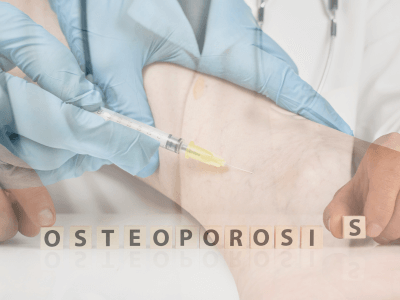Osteoporosis is a pervasive condition marked by the weakening of bones, which increases their susceptibility to fractures. Often referred to as the “silent disease,” osteoporosis progresses without overt symptoms, making early detection critical. This comprehensive blog provides insights into the diagnosis, treatment options, and steps you can take to safeguard your bone health.
What is Osteoporosis?
Osteoporosis is a skeletal disorder characterized by low bone mass and deterioration of bone tissue. This results in bones becoming fragile and prone to fractures, even from minor falls or stresses such as coughing or bending.
Who is at Risk?
While osteoporosis can affect anyone, certain groups are more vulnerable:
- Postmenopausal Women: Reduced estrogen levels accelerate bone loss.
- Men over 70: Lower testosterone levels can impact bone density.
- People with Certain Medical Conditions: Rheumatoid arthritis, hyperthyroidism, or gastrointestinal disorders can increase risk.
- Lifestyle Factors: Smoking, alcohol use, and a sedentary lifestyle contribute to bone loss.
Other risk factors include low calcium and vitamin D intake, family history of osteoporosis, and long-term use of corticosteroids.
How is Osteoporosis Diagnosed?
Early diagnosis is essential for effective management. Diagnostic steps typically include:
1. Bone Mineral Density (BMD) Test
The most common and accurate test for diagnosing osteoporosis is a DXA (Dual-Energy X-ray Absorptiometry) scan. It measures the density of bones in the hip, spine, and sometimes the wrist. Results are provided as a T-score:
- Normal Bone Density: T-score ≥ -1
- Osteopenia (Low Bone Mass): T-score between -1 and -2.5
- Osteoporosis: T-score ≤ -2.5
2. Fracture Risk Assessment Tool (FRAX)
This tool evaluates an individual’s 10-year risk of major osteoporotic fractures based on factors such as age, gender, bone density, and medical history.
3. Blood and Urine Tests
These tests help identify secondary causes of bone loss, such as hormonal imbalances, low calcium or vitamin D levels, or increased markers of bone turnover.
Treatment Options for Osteoporosis
Treatment aims to reduce the risk of fractures, strengthen bones, and address any underlying conditions.
1. Lifestyle and Dietary Changes
Calcium and Vitamin D
- Calcium: Adults aged 50+ should aim for 1,200 mg daily.
- Vitamin D: Adults require 800-1,000 IU daily, obtained through sunlight, food, or supplements.
Exercise
- Weight-bearing Exercises: Activities like walking, dancing, or jogging help maintain bone density.
- Strength Training: Resistance exercises build muscle strength and improve balance.
Avoid Harmful Habits
- Quit smoking and limit alcohol consumption, as both negatively impact bone health.
2. Pharmacological Treatments
Depending on your fracture risk and bone density, doctors may prescribe medications:
- Bisphosphonates: Drugs like alendronate, risedronate, and zoledronic acid slow bone loss and improve bone density.
- Selective Estrogen Receptor Modulators (SERMs): Medications like raloxifene mimic estrogen’s bone-protective effects.
- Parathyroid Hormone Analogs: Drugs such as teriparatide stimulate bone formation and are used for severe osteoporosis.
- RANK Ligand Inhibitors: Denosumab reduces bone resorption and is administered as a biannual injection.
- Hormone Replacement Therapy (HRT): Beneficial for postmenopausal women but carries potential risks, such as blood clots and certain cancers.
3. Fall Prevention Strategies
Since fractures often result from falls, it’s crucial to minimize fall risks:
- Use non-slip mats and install grab bars in bathrooms.
- Ensure proper lighting throughout your home.
- Engage in balance-enhancing exercises like tai chi or yoga.
Preventive Measures
Osteoporosis prevention begins with maintaining strong bones throughout life.
1. Nutrition for Bone Health
- Incorporate calcium-rich foods such as dairy, leafy greens, fortified cereals, and tofu into your diet.
- Consume foods high in magnesium, phosphorus, and vitamin K, which support bone structure.
2. Stay Physically Active
- Weight-bearing activities: Walking, dancing, or climbing stairs helps maintain bone strength.
- Muscle-strengthening exercises: Resistance bands or light weights can prevent bone and muscle loss.
3. Routine Screening
- Women aged 65+ and men aged 70+ should undergo routine BMD testing.
- Younger individuals with risk factors (e.g., family history, fractures, or medical conditions) should consult their doctor for earlier screening.
Living with Osteoporosis
For individuals diagnosed with osteoporosis, proactive management can improve quality of life and prevent complications.
1. Stay Informed
Educate yourself about your condition and treatment options. Reliable resources and support groups can provide valuable insights.
2. Medication Adherence
Take prescribed medications as directed. Missing doses can reduce their effectiveness.
3. Regular Follow-Ups
Work closely with your healthcare provider to monitor bone health and adjust treatment plans as needed.
4. Be Prepared for Emergencies
If you experience a fracture or severe bone pain, seek medical attention promptly.
Frequently Asked Questions
1. Is osteoporosis reversible?
While osteoporosis itself cannot be completely reversed, its progression can be slowed or halted with the right treatment and lifestyle changes.
2. Are fractures inevitable if I have osteoporosis?
No. Many individuals with osteoporosis live fracture-free lives by adhering to treatment plans and taking preventive measures.
3. How soon can I see results from treatment?
Improvements in bone density typically take 6-12 months with consistent treatment. However, fracture risk reduction begins sooner.
4. Can men develop osteoporosis?
Yes. Though more common in women, osteoporosis also affects men, particularly those over 70 or with risk factors like low testosterone or corticosteroid use.
The Role of Florida Endocrinology and Diabetes Center
At Florida Endocrinology and Diabetes Center, we specialize in personalized care for osteoporosis. Our team provides:
- Comprehensive Diagnostics: Advanced BMD testing and lab evaluations.
- Individualized Treatment Plans: Tailored therapies to meet each patient’s needs.
- Ongoing Support: Education and guidance to empower patients in managing their condition.
Conclusion
Osteoporosis is a manageable condition with the right combination of early diagnosis, effective treatment, and preventive measures. By taking a proactive approach to bone health, you can reduce fracture risk, maintain mobility, and improve your overall quality of life.
If you’re concerned about your bone health, schedule an appointment with the experts at Florida Endocrinology and Diabetes Center today. Together, we’ll help you build and maintain stronger, healthier bones for years to come.

